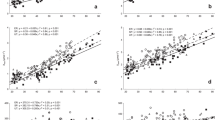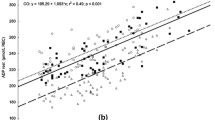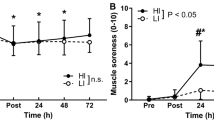Abstract
Changes in purine derivatives may be considered as signs of training-induced metabolic adaptations. The purpose of this study was to assess the effect of a 1-year training cycle on the response of hypoxanthine (Hx) concentration and Hx–guanine phosphoribosyltransferase (HGPRT) activity. Three groups of middle-aged male runners were examined: 11 elite master runners (EL; 46.0 ± 3.8 years), 9 amateur runners (AM; 45.1 ± 4.7 years), and 10 recreational runners (RE; 45.9 ± 6.1 years). Plasma Hx concentration and erythrocyte HGPRT activity were measured in three characteristic training phases of the annual cycle. Significant differences in post-exercise Hx concentration and resting HGPRT activity were demonstrated between the EL, AM, and RE groups across consecutive training phases. The EL group showed lowest Hx concentration and highest HGPRT activity compared to the AM and RE groups. Analogous differences were observed between the AM and RE groups during specific preparation. For the EL group, the changes were observed across all examinations and the lowest Hx concentration and highest HGPRT activity were found in the competition phase. Significant change was also revealed in the AM group between the general and specific preparation, but not in the competition phase. No significant changes were found in the RE runners who did not use anaerobic exercise in their training. In conclusion, a long-lasting endurance training, incorporating high-intensity exercise, results in significant changes in purine metabolism, whereas training characterized by constant low-intensity exercise does not. Plasma Hx concentration and erythrocyte HGPRT activity may be sensitive indicators of training adaptation and training status in middle-aged athletes.


Similar content being viewed by others
Abbreviations
- AdN:
-
Adenine nucleotide
- AM:
-
Amateur runners
- AMP:
-
Adenosine monophosphate
- AMPd:
-
Adenosine monophosphate deaminase
- ANOVA:
-
Analysis of variance
- ATP:
-
Adenosine triphosphate
- BMI:
-
Body mass index
- CO2 :
-
Carbon dioxide
- EL:
-
Elite master runners
- Hb:
-
Hemoglobin
- HClO4 :
-
Perchloric acid
- HGPRT:
-
Hypoxanthine–guanine phosphoribosyltransferase
- HPLC:
-
High-performance liquid chromatography
- Hx:
-
Hypoxanthine
- IMP:
-
Inosine monophosphate
- Ino:
-
Inosine
- K2CO3 :
-
Potassium carbonate
- KH2PO4 :
-
Potassium phosphate
- LApost :
-
Post-exercise plasma concentration of lactate
- MANOVA:
-
Multiple analysis of variance
- MgCl2 :
-
Magnesium chloride
- NADH:
-
Nicotine adenine dinucleotide, reduced
- NH3 :
-
Ammonia
- O2 :
-
Oxygen
- PRPP:
-
Phosphoribosyl pyrophosphate
- RE:
-
Recreational runners
- SD:
-
Standard deviation
- TBAS:
-
Tetrabutylammonium sulfate
- UA:
-
Uric acid
- UV:
-
Ultraviolet
- \( \dot{V}_{\text{E}} \) :
-
Ventilation
- \( \dot{V}_{{{\text{O}}_{2} }} \) :
-
Oxygen uptake
- \( \dot{V}_{{{\text{O}}_{{ 2 {\text{GET}}}} }} \) :
-
Oxygen uptake at gas exchange threshold
- \( \dot{V}_{{{\text{O}}_{2\hbox{Max} } }} \) :
-
Maximal oxygen uptake
- X:
-
Xanthine
References
Baldwin J, Snow RJ, Gibala MJ, Garnham A, Howarth K, Febbraio MA (2003) Glycogen availability does not affect the TCA cycle or TAN pools during prolonged, fatiguing exercise. J Appl Physiol 94:2181–2187
Banaszak F (1999) The metabolism of purine and pyrimidine nucleotides in essential hypertension. The assessment of the influence of antihypertensive drugs [in Polish]. University School of Physical Education, Poznań
Beaver WL, Wasserman K, Whipp BJ (1986) A new method for detecting anaerobic threshold by gas exchange. J Appl Physiol 60:2020–2027
Bhattacharya AK, Panda PK, Das Gupta PK, De AK (1983) Pattern of venous lactate and pyruvate after submaximal exercise in athletes training in different disciplines. Int J Sports Med 4:252–254
Bianchi GP, Grossi G, Bargossi AM, Fiorella PL, Marchesini G (1999) Can oxypurines plasma levels classify the type of physical exercise? Sports Med Phys Fit 39:123–127
Bompa T (1999) Periodization. Theory and methodology of training. Human Kinetics, Champaign
Ellsworth ML, Forrester T, Ellis CG, Dietrich HH (1995) The erythrocyte as a regulator of vascular tone. Am J Physiol Heart Circ Physiol 269:H2155–H2161
Gutmann J, Wahlenfeld AW (1974) l-/± lactate determination with lactate dehydrogenase and NAD. In: Bergmayer HU (ed) Methods of enzymatic analysis. Academic Press, New York, pp 1586–1587
Harkness RA, Simmonds RJ, Coade SB (1983) Purine transport and metabolism in man: the effect of exercise on concentrations of purine bases, nucleosides and nucleotides in plasma urine, leucocytes and erythrocytes. Clin Sci (Lond) 64:333–340
Hellsten-Westing Y, Ekblom B, Sjödin B (1989) The metabolic relation between hypoxanthine and uric acid in man following maximal short-distance running. Acta Physiol Scand 137:341–345
Hellsten-Westing Y, Sollevi A, Sjödin B (1991) Plasma accumulation of hypoxanthine, uric acid and creatine kinase following exhausting runs of differing durations in man. Eur J Appl Physiol Occup Physiol 62:380–384
Hellsten-Westing Y, Balsom PD, Norman B, Sjödin B (1993a) The effect of high-intensity training on purine metabolism in man. Acta Physiol Scand 149:405–412
Hellsten-Westing Y, Norman B, Balsom PD, Sjödin B (1993b) Decreased resting levels of adenine nucleotides in human skeletal muscle after high-intensity training. J Appl Physiol 74:2523–2528
Hellsten-Westing Y, Kaijser L, Ekblom B, Sjödin B (1994) Exchange of purines in human liver and skeletal muscle with short-term exhaustive exercise. Am J Physiol 266:R81–R86
Hellsten Y, Tullson PC, Richter EA, Bangsbo J (1997) Oxidation of urate in human skeletal muscle during exercise. Free Radic Biol Med 22:169–174
Hellsten Y, Richter EA, Kiens B, Bangsbo J (1999) AMP deamination and purine exchange in human skeletal muscle during and after intense exercise. J Physiol 520:909–920
Hellsten Y, Svensson M, Sjödin B, Smith S, Christensen A, Richter EA, Bangsbo J (2001) Allantoin formation and urate and glutathione exchange in human muscle during submaximal exercise. Free Radic Biol Med 31:1313–1322
Kaya M, Moriwaki Y, Ka T, Inokuchi T, Yamamoto A, Takahashi S, Tsutsumi Z, Tsuzita J, Oku Y, Yamamoto T (2006) Plasma concentrations and urinary excretion of purine bases (uric acid, hypoxanthine, and xanthine) and oxypurinol after rigorous exercise. Metabolism 55:103–107
Löwenstein JM (1972) Ammonia production in muscle and other tissues: the purine nucleotide cycle. Physiol Rev 52:382–414
Manfredi JP, Holmes EW (1984) Control of the purine nucleotide cycle in extracts of rat skeletal muscle: effects of energy state and concentrations of cycle intermediates. Arch Biochem Biophys 233:515–529
Namm DH (1973) Myocardial nucleotide synthesis from purine bases and nucleosides. Comparison of the rates of formation of purine nucleotides from various precursors and identification of the enzymatic routes for nucleotide formation in the isolated rat heart. Circ Res 33:686–695
Olearczyk JJ, Ellsworth ML, Stephenson AH, Lonigro AJ, Sprague RS (2004) Nitric oxide inhibits ATP release from erythrocytes. J Pharmacol Exp Ther 309:1079–1084
Rychlewski T, Banaszak F, Szczęśniak Ł, Konys L, Jastrzębski A (1997) Plasma hypoxanthine as an indicator of exercise intensity [in German]. Sportonomics 1:47–52
Sahlin K, Broberg S (1990) Adenine nucleotide depletion in human muscle during exercise: causality and significance of AMP deamination. Int J Sports Med 11:S62–S67
Sahlin K, Ekberg K, Cizinsky S (1991) Changes in plasma hypoxanthine and free radical markers during exercise in man. Acta Physiol Scand 142:275–281
Sahlin K, Tonkonogi M, Söderlund K (1999) Plasma hypoxanthine and ammonia in humans during prolonged exercise. Eur J Appl Physiol Occup Physiol 80:417–422
Saiki S, Sato T, Hiwatari M, Harada T, Oouchi M, Kamimoto M (1999) Relation between changes in serum hypoxanthine levels by exercise and daily physical activity in the elderly. Tohoku J Exp Med 188:71–74
Sjödin B, Hellsten-Westing Y (1990) Changes in plasma concentration of hypoxanthine and uric acid in man with short-distance running at various intensities. Int J Sports Med 11:493–495
Smoleński RT, Fabianowska-Majewska K, Montero C, Duley JA, Fairbanks LD, Marlewski M, Simmonds HA (1992) A novel route of ATP synthesis. Biochem Pharmacol 43:2053–2057
Spencer M, Bishop D, Lawrence S (2004) Longitudinal assessment of the effects of field hockey training on repeated sprint ability. J Sci Med Sport 7:323–334
Sprague RS, Ellsworth ML, Stephenson AH, Lonigro AJ (1996) ATP: the red blood cell link to NO and local control of the pulmonary circulation. Am J Physiol 271:H2717–H2722
Stathis CG, Febbraio MA, Carey MF, Snow RJ (1994) Influence of sprint training on human skeletal muscle purine nucleotide metabolism. J Appl Physiol 76:1802–1809
Stathis CG, Carey MF, Hayes A, Garnham AP, Snow RJ (2006) Sprint training reduces urinary purine loss following intense exercise in humans. Appl Physiol Nutr Metab 31:702–708
Stolk JN, De Abreu RA, Boerbooms AM, de Koning DG, de Graaf R, Kerstens PJ, van de Putte LB (1995) Purine enzyme activities in peripheral blood mononuclear cells: comparison of a new non-radiochemical high-performance liquid chromatography procedure and a radiochemical thin-layer chromatography procedure. J Chromatogr B 666:33–43
Sutton JR, Toews CJ, Ward GR, Fox IH (1980) Purine metabolism during strenuous muscular exercise in man. Metabolism 29:254–260
Tullson PC, Terjung RL (1991) Adenine nucleotide synthesis in exercising and endurance-trained skeletal muscle. Am J Physiol 261:C342–C347
Wung WE, Howell SB (1980) Simultaneous liquid chromatography of 5-fluorouracil, uridine, hypoxanthine, xanthine, uric acid, allopurinol and oxipurinol in plasma. Clin Chem 26:1704–1708
Zieliński J, Kusy K (2012) Training-inducted adaptation in purine metabolism in high-level sprinters vs. triathletes. J Appl Physiol 112:542–551
Zieliński J, Rychlewski T, Kusy K, Domaszewska K, Laurentowska M (2009) The effect of endurance training on changes in purine metabolism: a longitudinal study of competitive long-distance runners. Eur J Appl Physiol 106:867–876
Zieliński J, Kusy K, Rychlewski T (2011) Effect of training load structure on purine metabolism in middle-distance runners. Med Sci Sports Exerc 43:1798–1807
Acknowledgments
The authors thank the athletes for their full participation. This work was funded by the Polish Ministry of Science and Higher Education from financial resources destined for scientific activity in years 2010–2011 (Application and Grant Number: N N404 191536).
Ethical standards
The authors declare that the experiments comply with the current laws of Poland.
Conflict of interest
The authors declare that they have no conflict of interest.
Author information
Authors and Affiliations
Corresponding author
Additional information
Communicated by Michael Lindinger.
Rights and permissions
About this article
Cite this article
Zieliński, J., Kusy, K. & Słomińska, E. Alterations in purine metabolism in middle-aged elite, amateur, and recreational runners across a 1-year training cycle. Eur J Appl Physiol 113, 763–773 (2013). https://doi.org/10.1007/s00421-012-2488-4
Received:
Accepted:
Published:
Issue Date:
DOI: https://doi.org/10.1007/s00421-012-2488-4




